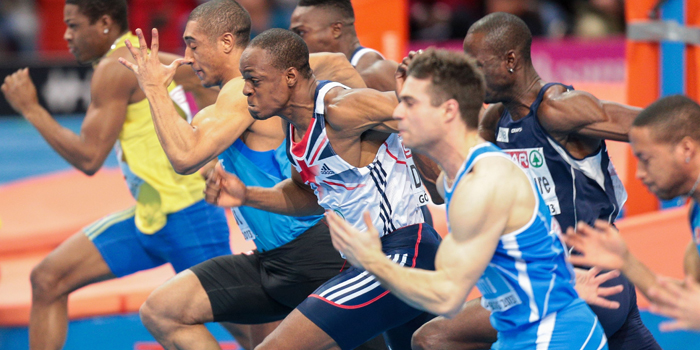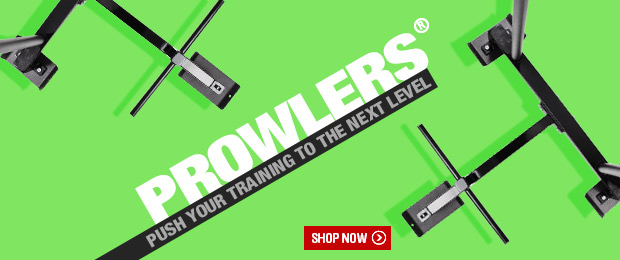
The development of sprint speed is an important objective for most athletes. Whether it’s acceleration, maximum velocity, or both, improving speed is a common goal of athletic strength and conditioning programs. Many methods for improving speed exist, and they are typically split into two categories: primary and secondary (Wagganer, Williams, & Barnes, 2014). Primary methods include technique work at various intensities, and secondary methods include resisted and assisted sprinting with various equipment.
Resisted sprinting involves the use of equipment to provide external resistance during sprinting. The equipment used includes weight sleds, parachutes, and resistance bands, with weight sleds being the most popular. Resisted sprinting aims to enhance muscular force output during movement patterns specific to sprinting (Cronin & Hansen, 2006). Numerous studies have been conducted to determine the effects of resisted sprinting methods on sprint speed. This article will sort through the findings to provide strength and conditioning professionals practical guidelines for implementing resisted sprinting exercises.
The Research
Let’s start with research from Edith Cowan University in Australia and the New Zealand Warriors Rugby Club. Researchers from these institutions performed a literature review on several sprint training methods, including resisted sprinting. They found that resisted sprinting has been shown to decrease short- to medium-range sprint times. They also found that combining resisted sprinting with assisted sprinting resulted in even greater reductions in sprint time over shorter distances (Cronin & Hansen, 2006).
Comparable results were found in the Department of Physical Education and Sport Science study at the University of Athens. Researchers at the university tested resisted sprint and un-resisted sprint methods on sprint athletes. The results of their study showed that sprint velocity was significantly higher in the resisted sprinting group compared to the un-resisted sprinting group during both the acceleration and maximum speed phases of a 50-meter sprint. The un-resisted sprint group showed no improvement during either phase (Martinopoulou, Argeitaki, Paradisis, Katsikas, & Smirniotou, 2011).
Similarly, researchers at the Sport Training Laboratory in Spain aimed to find the effects of resisted sprinting compared to un-resisted sprinting in field-sport athletes. They had the athletes perform resisted sprints with differing loads (5-30% of body mass) for 20 meters. Not only did they find that resisted sprinting worked well for improving speed, they also found that 20-meter sprint times were best improved with a load of 15% body mass during resisted sprints (Martinez, Gonzalez, Santos, Alcaraz, & Navarro, 2014). This supports recommendations found in the literature that resisted sprints should use between 10% and 30% of body mass to allow for maximal skill carryover (Clark & Lucett, 2010).
Further, members of the School of Exercise, Biomedical and Health Sciences at Edith Cowan University sought to see how the effects of resisted sprinting through sled towing and weight vests would compare with un-resisted sprinting. Results showed that resisted sprinting lead to greater thigh extension and trunk lean. With this information, the authors hypothesized that resisted sprinting is most appropriate for improving the acceleration phase of sprinting due to the increased trunk lean and thigh extension required during acceleration (Cronin, Hansen, Kawamori, & McNair, 2008). Members of the Department of Physical Education at the University of Murcia also discovered that resisted sprinting enhanced sprint performance during the acceleration phase after four weeks of training national-level athletes (Alcaraz, Elvira, & Palao, 2014).
What about combining both primary and secondary techniques? Researchers from Southeast Missouri State and Texas State University assessed the effects of primary and secondary speed training techniques on 40-yard sprint times in female college soccer players. The researchers found that four weeks of using both training methods resulted in statistically significant reductions in 40-yard sprint times (Wagganer, Williams, & Barnes, 2014). Likewise, researchers from the Sport Performance Research Institute of New Zealand discovered that combined training methods elicited the greatest improvements in sprint speed in highly trained athletes (Rumpf, Cronin, & Schneider, 2014).
Also, an experiment from the Department of Sport and Exercise Sciences at Northumbria University compared the effects of combined resisted sprinting and un-resisted sprint training against un-resisted sprint training alone on professional rugby players. They, too, discovered that a training program that combines both resisted sprinting and traditional sprint training leads to significantly better improvements in sprint performance than un-resisted sprinting alone (West, Cunningham, Bracken, Bevan, Crewther, Cook, & Kilduff, 2013).
Conclusion
Research on the effects of resisted sprinting on sprint speed has seen positive results. Several studies have determined that resisted sprint exercises can help improve an athlete’s speed, particularly during the acceleration phase. Also, multiple studies have concluded that mixing both resisted sprinting and un-resisted sprinting techniques leads to the greatest speed improvements.
Based on this information, it seems that coaches and athletes can’t go wrong with implementing a comprehensive approach to sprint training by including all forms. Using both primary and secondary sprint training techniques seems to be an effective method for improving sprint speed in athletes.
References
- Alcaraz, P. E., Elvira, J. L., & Palao, J. M. (2014). Kinematic, strength, and stiffness adaptations after a short-term sled towing training in athletes. Scandinavian Journal of Medicine & Science in Sports, 24 (2), 279-291.
- Clark, M. A., & Lucett, S. C. (2010). NASM Essentials of Sports Performance Training. Baltimore, MD: Lippincott Williams & Wilkins.
- Cronin, J., & Hansen, K. T. (2006). Resisted sprint training for the acceleration phase of sprinting. Strength & Conditioning Journal, 28 (4), 42-52.
- Cronin, J., Hansen, K., Kawamori, N., & McNair, P. (2008). Effects of weighted vests and sled towing on sprint kinematics. Sports Biomechanics, 7 (2), 160-173.
- Martinez, M. A., Gonzalez, J. M., Santos, D. J., Alcaraz, P. E., & Navarro, F. (2014). Interrelationships between different loads in resisted sprints, half-squat 1 RM and kinematic variables in trained athletes. European Journal of Sport Science, 14, 18-24.
- Martinopoulou, K., Argeitaki, P., Paradisis, G., Katsikas, C., & Smirniotou, A. (2011). The effects of resisted training using parachute on sprint performance. Biology of Exercise, 7 (1), 7-24.
- Rumpf, M. C., Cronin, J. B., & Schneider, C. (2014). Effect of different training methods on sprint times in recreational and athletic males. Journal of Australian Strength & Conditioning, 22 (4), 62-74.
- Wagganer, J. D., Williams, R. D., & Barnes, J. T. (2014). The effects of a four week primary and secondary speed training protocol on 40 yard sprint times in female college soccer players. Journal of Human Sport & Exercise, 9 (3), 713-727.
- West, D. J., Cunningham, D. J., Bracken, R. M., Bevan, H. R., Crewther, B. T., Cook, C. J., & Kilduff, L. P. (2013). Effects of resisted sprint training on acceleration in professional rugby union players. Journal of Strength & Conditioning Research, 27 (4), 1014-1019.
Header image credit: hkratky © 123rf.com

Danny Takacs is a personal trainer in Cincinnati, Ohio. He is the owner of Kratos Elite Fitness, a private training facility that gets clients into their prime physical condition. Danny has a master's degree in Exercise Science from the California University of Pennsylvania and holds certifications from the National Academy of Sports Medicine and USA Weightlifting. Danny is a competitive weightlifter and powerlifter.










Thanks for sharing! Short and concise and reminds me to keep incorporating resisted sprints with my athletes.